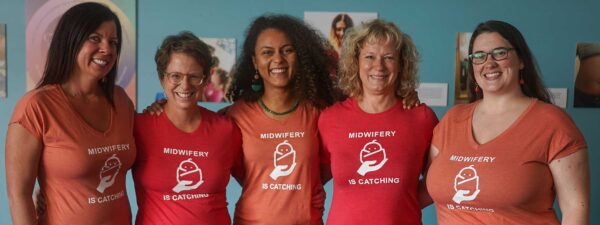To Decrease Black Maternal Mortality, Midwives and Money Could Make the Difference
Trained midwives at community health centers provided accessible care to pregnant patients, and more is needed.
By Olivia Lewis
MAY 13, 2023 6:34 AM
Black mothers continue to die at a higher rate before, during, and after childbirth than any other ethnic group in the United States. Last year, 1,205 soon-to-be and recent mothers in the United States died, and 84 percent of those deaths could have been prevented.
Last month, the Centers for Disease Control and Prevention reported a 40 percent increase in maternal-related deaths in 2021 from 2020. Experts say lack of access to care, fear of not receiving proper care due to systemic racism, and comorbidities have contributed to the increase in their deaths. A litany of legislative decisions could change maternal health outcomes across the United States, if approved.
Amongst the urgency for change, midwives have stood out as a supportive resource to parents who want to feel seen, heard, and cared for during the birthing process and decreasing the overall risk of death. However, there aren’t enough midwives or obstetricians in the communities that need them.
“The comorbidities are real,” said Pandora Hardtman, a certified and practicing midwife, and Chief Nursing and Midwifery Officer for Jhpiego, a global health nonprofit focused on the health of women and families and that is affiliated with the Johns Hopkins University.
Black women’s maternal mortality rate was 37.3 deaths for every 100,000 live births in 2018; 44 in 2019; 55.3 in 2020; and 69.9 in 2021. In contrast, white women’s mortality rates were 14.9 deaths for every 100,000 live births in 2018; 17.9 in 2019; 19.1 in 2020; and 26.6 in 2021. For Hispanic women, the rates were 11.8 in 2018; 12.6 in 2019; 18.2 in 2020; and 28 in 2021.
 Midwife Julie Kellon works with parents at a birthing class. Kellon works at Neighborhood Family Practice, where she is one of five midwives on staff at the community health center in Ohio. (Photo courtesy of Neighborhood Family Practice)
Midwife Julie Kellon works with parents at a birthing class. Kellon works at Neighborhood Family Practice, where she is one of five midwives on staff at the community health center in Ohio. (Photo courtesy of Neighborhood Family Practice)
The maternal death rate for black women is 2.6 times the rate of white women, though death rates for all women significantly increased in the past year.
Hardtman said that comorbidities like diabetes, preeclampsia, hypertension and mental illnesses have contributed to maternal mortality. The midwife said that now, as more stories are shared about the lack of cultural awareness and ongoing systemic racism within larger health systems, some soon-to-be mothers are fearful of seeking the care they need.
Finding care can be difficult, especially for those who live in rural areas. Hardtman said that there aren’t enough places for incoming midwives to receive proper in-person training, and overall access to midwifery care is centered in wealthy, predominantly white neighborhoods across the United States.
The Health Resources and Services Administration reported that just 13,409 nurse midwives and certified midwives were employed in the United States in 2021. The National Center for Workforce Analysis reported that 10.3 million women lived in counties without obstetricians and that within the next eight years, there will be a shortage of over 5,000 obstetricians nationwide.
Katy Maistros, a midwife in Cleveland, Ohio, said that when the birthing unit in neighboring Medina County closed, pregnant people didn’t have a place to go within their county to birth their babies. She said there aren’t enough midwives to serve the pregnant people in the area and not enough Black and brown midwives to bridge the cultural gaps necessary to improve health outcomes.
An annual report released by the Ohio Equity Institute shared that Cuyahoga County’s infant mortality rate was 7.6 per 1,000 live births. The Black infant death rate was 14.6 compared to 3.2 per 1,000 for white infants.
“The root cause is chronic stress and racism. It’s dismissible, its implicit bias, it’s the attitude of the health system,” Maistros said. “And that’s coming from a white, 47-year-old woman.”
Maistros is the Associate Medical Director of Midwifery Services at Neighborhood Family Practice Community Health Centers, a Federally Qualified Health Center in Cleveland, Ohio. The practice has a partnership with the local hospital, five midwives on staff and a visiting obstetrician. The midwife said it has been difficult to find midwives of color who have finished their practicum and clinical requirements over the last two years, as students were shut out of in-person programs during the pandemic.
The need for more ethnically and culturally diverse staff is proven within their client demographics. Last year, Maistros said that 35 percent of their patients speak a language other than English. The practice uses philanthropic dollars to support transportation and translation services to communicate with patients who speak 11 different languages.
But more midwives won’t solve the issue if policies don’t also change, according to Maistros. The midwife said that socioeconomic factors weigh on women who don’t have access to maternal leave, who don’t have postpartum support, and are dealing with mental health challenges throughout the pregnancy process.
“Our country is abhorrent when it comes to post-partum, and family leave laws,” she said. “I had a lady, who ironically was a health aide worker, leave on Nov. 4th and asked me for a return-to-work order ten days post-partum. She’s not even done bleeding. That’s really what’s killing women. We can’t afford to have a baby.”
The federal government has long mulled further support for midwifery services which could decrease rates of Black maternal mortality. Last year, Democratic members of the Senate introduced a group of 12 bills to funnel $1.7 trillion in support for mothers and babies in predominantly Black communities.
The package, or Black Maternal Health Momnibus Act of 2021, is likely to be passed one by one over time. The first was passed in December as a provision of the Build Back Better Act. Legislators have proposed to extend 24-month postpartum eligibility to Special Supplemental Nutrition Program and Women, Infants and Children program. It would force agencies to take action to grow and diversify the maternal health workforce, increase access to maternal care, increase research and data collection, and specifically improve maternal health among racial and ethnic minority groups.
“(Momnibus) It’s a really big deal, and it is exciting,” said Erin Ryan, a midwife and global health consultant. At the state level, efforts to increase access are also changing. There are 35 states, including Ohio, that have increased Medicaid postpartum coverage to 12 months.
Ryan said the investment needs to support Black mothers and Black midwives to make a difference. “We need to be clear that it is Black women who are dying,” she said. “And that Native women are dying.”
Last summer, the U.S. Supreme Court overturned Roe v. Wade, outlawing abortions at the federal level. Just five states used the midterm election to protect a women’s right to choose within specific time constraints of conception: California, Vermont, Michigan, Kentucky, and Montana.
“It’s not helpful to have 200,000 midwives and put them in areas of wealth with good insurance,” Ryan said at the time. “Another factor that is going to come up in the next couple of years are restrictions on abortion and abortion bans (because of) pregnancies that have to be carried to term that are higher risk. It is going to affect anyone with of a lower socioeconomic threshold who can’t go where they need to go to receive the care that they need.”
Direct Relief has supported maternal health efforts, including reproductive health and pre-and post-natal care, at community health centers across the United States.

